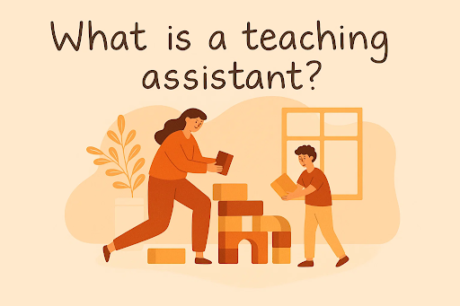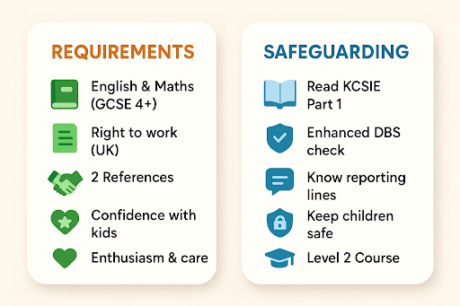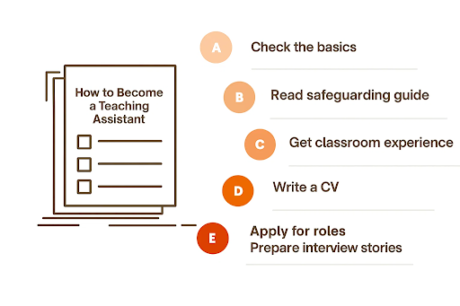What is a teaching assistant? It’s someone who helps pupils learn, keeps lessons running smoothly, and supports the teacher daily. Meanwhile, in the UK, you qualify by showing strong English and maths, passing an enhanced DBS check, and gaining some classroom experience. Then, you can apply directly or through a Level 3 apprenticeship to start your journey.

In this guide, you’ll discover what teaching assistants do, the skills you need, and the best ways to start your first role in the classroom.
What Is a Teaching Assistant?
A teaching assistant is like the class’s friendly sidekick. They help kids with tricky bits, keep the day on track, and make sure everyone feels settled. They jump into reading groups, join in with phonics games, and step in whenever things get a bit bumpy. Because they handle the little things and keep the mood calm, the teacher can focus on teaching without stress.
What Does A Teaching Assistant Do?
- Run lively reading groups.
- Turn phonics into fun games.
- Support pupils one-to-one
- Set up resources in a flash.
- Create eye-catching display boards.
- Supervise and play on the playground.
- Smooth out classroom transitions.
- Give quick, helpful feedback.
Teaching Assistant Requirements UK
To work as a teaching assistant in the UK, you need basic English and maths (GCSE grade 4 or equivalent). You also need the right to work here, a couple of references, and confidence around kids. Don’t worry if you’re switching careers—schools love people who are enthusiastic, caring, and ready to make a difference.
Safeguarding and DBS
Before you start, you’ll read Keeping Children Safe in Education (KSCIE) Part 1 and do an enhanced DBS check. This keeps children safe and shows schools they can trust you. You’ll also know exactly who to talk to if something worries you, so you can help quickly and confidently. It might feel a bit formal at first, but it’s all about keeping children safe and giving you peace of mind while you do this important job.
To build your knowledge further, check out our Level 2 Safeguarding Children Training Course.

Routes Into the Job
There are a few ways to become a teaching assistant. You can apply straight to schools or academy trusts and start working with children right away. Or, you could do a Level 3 Teaching Assistant apprenticeship—you’ll learn on the job, earn money, and gain real experience. Another option is a short volunteering stint at a school, which often leads to a paid role. It’s a great way to try out the job, see if it suits you, and get your foot in the door.
How to Become a Teaching Assistant: Step by Step

1. Check the basics
First, make sure you have GCSE English and maths at grade 4/C or equivalent. You also need the right to work in the UK and two good referees. Most importantly, stay calm and friendly around children, because your attitude makes a huge difference every day.
2. Read the safeguarding guide
Next, read Keeping Children Safe in Education Part 1. It explains how to spot if a child might need help. Also, you’ll understand who to talk to if something worries you, so you can act quickly and feel confident.
3. Get a little classroom experience
Then, try helping out for a few mornings in reading groups or one-to-one support. Even short, school-approved volunteering gives you real experience. Plus, it shows schools you’re serious and ready to help children.
4. Write a one-page CV
After that, write a simple CV that leads with any experience with children. Include your knowledge of safeguarding, helping with behaviour, literacy and any work with SEND or EAL pupils. Remember to keep it friendly, clear, and focused on what you can do for the classroom.
5. Apply to live roles
Next, look for jobs on Teaching Vacancies, local council sites, or academy trusts. Use terms like Teaching Assistant, SEN TA, one-to-one, or learning support to find the right role. Also, in your application, show your enthusiasm and love for working with children.
6. Prepare three short interview stories
Finally, think of short examples for interviews: how you keep pupils safe, a time you helped a child “get it,” and what you would do if worried about a pupil. Make sure each story is under a minute. Practising these helps you feel calm and ready on the day.
Common Challenges for Teaching Assistants
Challenges
- Supporting pupils who struggle to stay focused
- Managing children with challenging behaviour
- Balancing one-to-one support with overseeing the whole class
- Feeling overwhelmed in the early stages of the role
How to Handle These Challenges
- Stay patient and calm in every situation
- Use clear, positive communication to guide pupils
- Rely on the support and direction of the class teacher
- Remember that confidence grows with time and practice
The Benefits
- Build strong classroom management skills
- Gain confidence in handling a variety of situations
- Turn challenges into opportunities for growth
- Make a lasting, positive difference in children’s lives
Where to Find Teaching Assistant Jobs
Finding a teaching assistant job is easier than you think. First, check the Teaching Vacancies section on the Department for Education website. Then, look at local council job boards and academy trust websites. Also, use simple search words like Teaching Assistant, SEN TA, one-to-one, or learning support to find the right role. This way, you can see all your options and pick a job that feels right for you.
CV and Cover Note That Get Callbacks
To get noticed, keep your CV and cover note simple and friendly. Start by showing any experience you have working with children. Then, mention that you understand safeguarding, can help with behaviour and are confident in literacy and maths. Also, add any work with SEND or EAL pupils. Finally, include when you’re available and who can give you a reference. This way, schools can quickly see you’re ready, caring, and perfect for the job.
Interview Basics That Win Offers
To do well in your interview, get three quick answers ready. First, explain how you keep pupils safe every day. Then, tell a short story about a time you helped a child “get it” or understand something tricky. Also, share what you would do if you ever felt worried about a pupil. By keeping your examples short, friendly, and warm, you show you care and are ready to make a real difference in the classroom.
Hours and Pay in Plain English
Most teaching assistant jobs are term-time, so you work when school is open, not during holidays. Additionally, pay is usually spread evenly across the year, which helps with budgeting. Hourly rates typically range from £12 to £16 per hour, depending on experience, role and location. Adverts often show a full-time salary, but your actual pay depends on the hours you work and the weeks you’re paid. Knowing this helps you plan your money and avoid surprises.
Progression and What Comes Next
Once you’re comfortable as a teaching assistant, there are lots of ways to grow. First, you can take on more responsibilities in the classroom. Then, you might focus on a special area, like SEND or literacy, to really build your skills. Next, you could become a Higher Level Teaching Assistant (HLTA), which gives you more duties and better pay. Finally, if you want, you could even train to become a teacher. Each step helps you feel more confident, skilled, and proud of the difference you make for the children every day.
Ready to take your career to the next level? Our HLTA Course – Higher Level Teaching Assistants at Unified Course is designed to guide you step by step, boost your skills, and help you reach the next level in your teaching journey.
FAQs
- What is the role of a teaching assistant?
They support the teacher, help pupils learn, run small groups, and keep the classroom calm and organised.
- How much is a TA paid in the UK?
Pay varies, but most TAs earn between £18,000 and £25,000 per year, depending on experience and hours.
- What qualities do you need to be a teaching assistant?
Patience, kindness, confidence with children, good communication, and a calm, friendly attitude.
- Is a teaching assistant the same as a teacher?
No. TAs support teachers and pupils but don’t usually plan or lead lessons.
- Can a teaching assistant teach a class?
Only under a teacher’s guidance or in short supervised sessions. They don’t lead full lessons independently.
Final Thoughts
So, what is a teaching assistant? It’s a job where you help teachers, support pupils and really make a difference every day. Also, there are lots of ways to get started, like applying to schools, volunteering, or doing an apprenticeship. If you want to feel confident and ready for the role, the Teaching Assistant Course from Unified Course can help you learn all the skills you need.
So why wait? Sign up today for the Unified Course and step into the classroom and make a difference.





